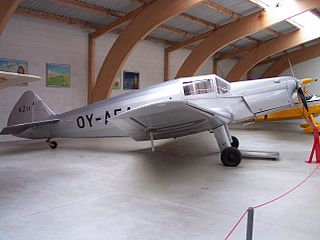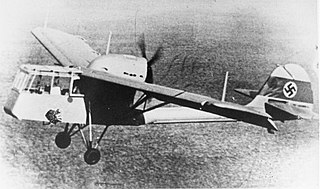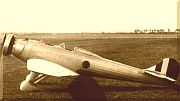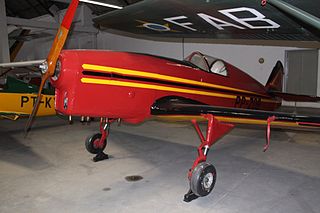
The Fieseler F2 Tiger was a German single-seat aerobatic biplane which was flown to victory in the 1934 World Aerobatics Competition (WAC) by its designer/builder Gerhard Fieseler.

The Fieseler Fi 157 was an unsuccessful attempt at developing a radio-controlled, full-sized anti-aircraft target.

The Messerschmitt Bf 163 was an STOL aircraft designed by BFW and built by Weser Flugzeugbau before World War II.

The Klemm Kl 35 is a German sporting and training aeroplane developed as a successor to the Kl 25. A product of Klemm Leichtflugzeugbau Gmbh it shared the same single-engine, cantilever low-wing configuration as the earlier machine, the major difference being the introduction of an inverted gull wing.

The Antonov A-13 was a Soviet aerobatic sailplane flown in the 1950s and 1960s. It was a small, single-seat, all-metal aircraft developed from the A-11 which could optionally be fitted with that aircraft's longer-span wings. It was a mid-wing monoplane with a tadpole-like fuselage and a V-tail.

The Beneš-Mráz Be-50 Beta-Minor was a light airplane manufactured in Czechoslovakia shortly before World War II.

The Fieseler Fi 97 was a 1930s German four-seat cabin touring and competition monoplane aircraft designed and built by the German manufacturer Fieseler.

Klemm L 25, later Klemm Kl 25 was a successful German light leisure, sports and training monoplane aircraft, developed in 1928. More than 600 aircraft were built, and manufacturing licenses were sold to the United Kingdom and the United States.

The Klemm Kl 36 is a 1930s German four-seat cabin touring and competition monoplane. It was designed by Klemm and Friedrich Fechner and built by Klemm.

The SAI KZ II was a sport aircraft built in Denmark in 1937, produced in three major versions before and after the Second World War.

The Siebel Si 202 Hummel ("Bumble-bee") was a German light sportsplane of the late 1930s. It was an angular low-wing monoplane, which could be powered by a variety of small engines.

The Siebel Si 201 was a German air observation post and army cooperation aircraft, designed and built by Siebel. Evaluated against other types, the Si 201 did not enter production and only two prototypes were built.

The Fieseler Fi 158 was a civilian research aircraft designed and built in Germany from 1938.
The Shackleton-Murray SM.1 was a single-engined two-seat light aircraft designed in Britain and flying in 1933. It was a pusher driven parasol winged monoplane. Only one was built.

The Fiat G.5 was an Italian two-seat aerobatic tourer or trainer designed and built by Fiat Aviazione in small numbers.

The Hirth Hi 27 Acrostar was designed by Arnold Wagner to win aerobatic competitions, in part by having handling independent of orientation, upright or inverted. A single engine, single seat low-wing monoplane, it was built in West Germany by Wolf Hirth GmbH in the early 1970s, and dominated Championships for a brief period.

The Heinkel He 71 was a German single-seat monoplane, a smaller version of the two-seat Heinkel He 64. A low-wing monoplane with a fixed conventional landing gear, the prototype first flew with an open cockpit and a 60 hp (45 kW) Hirth HM 60 engine. It was later modified with an enclosed cabin and a 78 hp (58 kW) Hirth HM 4 engine. With additional fuel tanks to increase range it was used by German aviator Elly Beinhorn on a flight around Africa.

The Fieseler Fi 99 Jungtiger was a German sports aircraft prototype, produced by Fieseler company. The aircraft was a low-wing two-seat aircraft with an enclosed cabin. It was powered by a Hirth HM 506A engine, producing 160 hp (119 kW).

The IPT-16 Surubim was a Brazilian single-seat, single engined experimental light aircraft. A single example was built and flown in 1959.

The Fieseler F 4 was developed, built and flown as a two-seat sports and travel aircraft at the Fieseler Flugzeugbau.



















